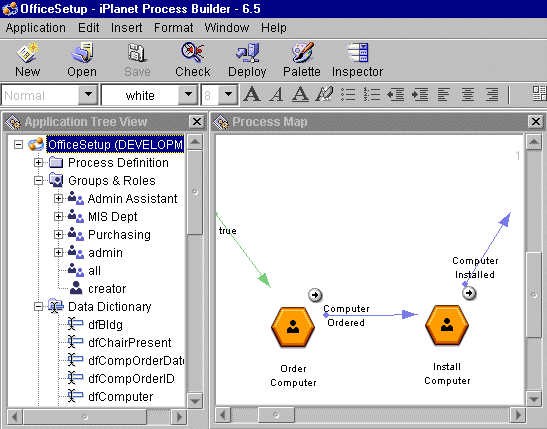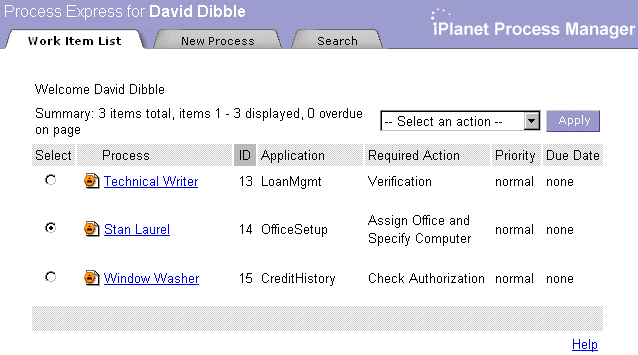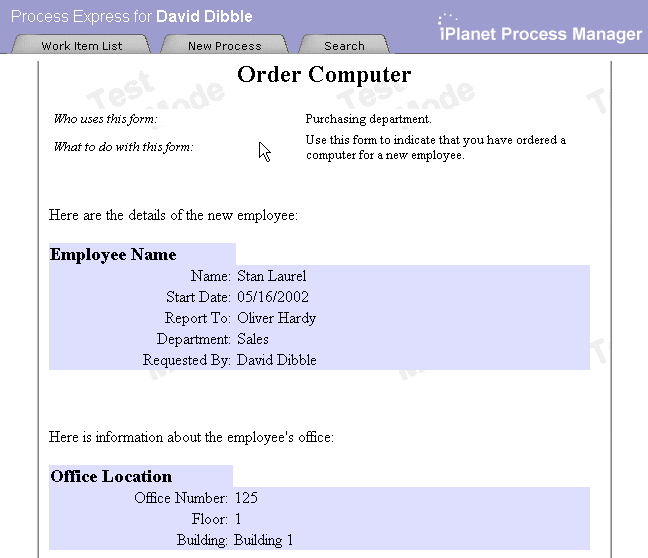|
|
| iPlanet Process Manager, Version 6.5 Process Builder's Guide |
Chapter 1 Overview of iPlanet Process Manager
Process Manager is a system for automating the flow of control for business processes. This chapter briefly discusses process workflow, and gives an overview of how Process Manager can be used to automate the flow of control in business processes.
This chapter has the following sections:
- "Workflow in Business Processes"
- "Designing a Process"
- "Performing Tasks in a Process"
- "Administering Processes"
- "Summary of Process Manager Components"
Workflow in Business Processes
Most business processes can be broken down into a series of discrete tasks to be performed by different people or groups of people or to be executed automatically. When one task is completed, the flow of control moves to the next task.
Consider the process for preparing an office for a new employee. Several different activities make up the process -- assigning an office, ordering a computer, installing the phone, installing the computer, and checking that the office furniture has been arranged properly. Some of these tasks need to be performed sequentially, for example, you must order the computer before installing it. Other tasks can be carried out in parallel, for example you don't need to wait for the computer to be ordered before installing the phone. Different people perform different tasks -- the purchasing department orders the computer, but the Information Systems department installs it when it arrives.
For another example, consider a process for submitting an insurance claim. The players and activities in this case include the customer submitting the claim; the computer retrieving details of the claimant's policy from a database; the insurance underwriter approving or denying the claim; and the finance department mailing the check.
Process Manager allows you to create web-based applications that define the different tasks in a process, specify who should perform them, and map out how the process flows from one task to another. The following list summarizes the tasks involved in using Process Manager:
- "Designing a Process"
Using the Process Builder component, process designers create and deploy an application that maps the steps in a business process.
- "Performing Tasks in a Process"
The Process Express component provides a web-based interface that aids the people assigned to perform a task.
- "Administering Processes"
The Process Administrator component provides a web-based interface for administrators to administer process applications, such as shutting down processes.
Designing a Process
Using Process Builder, a graphical user interface with drag and drop capability, you build a process application that controls the flow of a process. The process can contain tasks, or work items, that require human intervention such as approving a purchase request, as well as activities that can be completely automated such as retrieving data from databases and writing log files.
Figure 1-1 illustrates Process Builder.
Figure 1-1 Process Builder

Performing Tasks in a Process
When the process is deployed, Process Manager routes tasks at each step in the process to the users that need to perform them. Process Manager uses a web-based interface, called the Process Express, to interact with the users involved in the process. The Process Express displays a web-based work list that informs users of tasks that have been assigned, as illustrated in Figure 1-2.
Figure 1-2 The Worklist in the Process Express

When an assignee is ready to perform the task, they click on the task name. Process Express displays a form that provides the data needed to perform the task, as illustrated in Figure 1-3.
Figure 1-3 Example of a work item form

When an assignee has performed the task, they enter any data needed to complete the task and then submit the form. The work item automatically disappears from the assignee's work list. The process moves on to the next step and the next task shows up in the worklist of the appropriate user.
Process Manager automatically performs any automated tasks that do not require human intervention.
Administering Processes
Process Manager includes another set of web-based interfaces, called Process Administrator and Business Administrator, for performing administrative duties, such as shutting down deployed processes. Figure 1-4 shows one of the administrative interfaces.
Figure 1-4 Process Administrator

Summary of Process Manager Components
Table 1-1 summarizes the tasks involved in using Process Manager and describes where to go for more information about each one.
Providing the backend support to these interfaces is the Process Manager Engine, which performs the "behind the scenes" work of managing the process applications as well as performing and routing tasks in individual processes.
Process Manager requires various other software components to be installed, such as an application server and a directory server. See the Process Administrator's and Business Manager's Guide for more details about these additional components.
This manual discusses how to use Process Builder to design and deploy applications, and describes in detail the sample applications that ship with Process Builder.
Contents